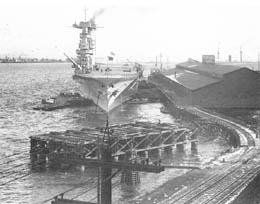Beginning on about December 17, 1929, the U.S. Navy aircraft carrier U.S.S. Lexington (CV-2) ties up to the Baker Dock and supplies electricity to Tacoma for a month to meet a power crisis.
In the 1920s, Tacoma received most of its electrical energy from dams on the Nisqually and Skokomish Rivers. Supplemental energy came from the Dock Street steam plant (1922). A drought in 1929 severely cut the power from the hydroelectric sources. The shortage became so critical that Superintendent Ira S. Davisson (1860-1951) had to cut power to Cascade Paper Company. Cascade laid off 300 employees. Fort Lewis turned the lights out in the barracks at 4:00 p.m.
Tacoma appealed to President Herbert Hoover, who bumped the matter to the Navy. At first the Secretary of the Navy refused the request, but negotiations resulted in a message to the Lexington’s captain to go to Tacoma, then to wait, then to go to Tacoma.
The request for the Lexington was opposed by Puget Sound Power & Light and by Seattle City Light, which claimed that the drought did not affect their operations. After the Lexington left Tacoma in January 1930, Seattle requested that the ship help out there. The Navy declined.
The "Lady Lex" arrived at Tacoma's Baker Dock in the rain to the sounds of a brass band and the applause of City Light customers. The Lexington’s boilers supplied a quarter of Tacoma’s power for about 30 days, leaving on January 17, 1930. That month, the skies opened and rain filled Tacoma’s reservoirs.
Tacoma enjoyed a special relationship with the carrier until its loss at the Battle of the Coral Sea on May 8, 1942.

